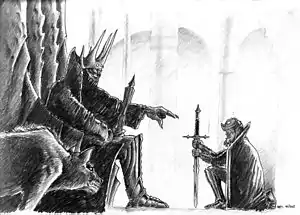Seigneur des Ténèbres
Le Seigneur des Ténèbres (ou Seigneur ténébreux) est un archétype propre au genre de la fantasy. Il désigne un puissant antagoniste démoniaque qui manifeste l'intention de dominer, désacraliser ou détruire le monde[1],[2], la galaxie ou l'univers.
Voir aussi
Bibliographie
- (en) Janet Brennan Croft, « Naming the Evil One : Onomastic Strategies in Tolkien and Rowling », Mythlore, vol. 28, no 1, automne-hiver 2009, p. 149-136 (lire en ligne).
- (en) A. J. Dalton, « Embodiments of Evil and Reflections of Social Change in Second-world Fantasy », dans Francesca T. Barbini (dir.), A Shadow Within : Evil in Fantasy and Science Fiction, Édimbourg, Luna Press Publishing, , 432 p. (ISBN 978-1-9111-4391-8), p. 73-101.
- (en) A. J. Dalton, The Satanic in Science Fiction and Fantasy, Édimbourg, Luna Press Publishing, , 152 p. (ISBN 978-1-913387-04-4).
- (en) David Day, The Dark Powers of Tolkien, Thunder Bay Press, , 256 p. (ISBN 978-1-68412-717-7).
- (en) Stefan Ekman, Here Be Dragons : Exploring Fantasy Maps and Settings, Middletown, Wesleyan University Press, , VIII-284 p. (ISBN 978-0-8195-7323-0, lire en ligne).
- (en) Joy Farmer, « The Magician's Niece : The Kinship between J. K. Rowling and C. S. Lewis », Mythlore, vol. 23, no 2, , p. 53-64 (lire en ligne).
- (en) William Indick, Ancient Symbology in Fantasy Literature : A Psychological Study, Jefferson, McFarland & Company, , 203 p. (ISBN 978-0-7864-6039-7), chap. 6 (« The Wizard and the Dark Lord »), p. 91-97.
- (en) Diana Wynne Jones, The Tough Guide to Fantasyland (en), Londres, Vista Books, , 223 p. (ISBN 978-0-575-60106-2). Édition revue : (en) Diana Wynne Jones, The Tough Guide to Fantasyland, New York, Firebird Books, , 234 p. (ISBN 978-0-7394-7914-8).
- (en) Thomas Moules, « "I have done only what was necessary" : An exploration of individual and structural evil in the works of N. K. Jemisin », dans Francesca T. Barbini (dir.), A Shadow Within : Evil in Fantasy and Science Fiction, Édimbourg, Luna Press Publishing, , 432 p. (ISBN 978-1-9111-4391-8), p. 248-262.
- (en) Mervyn Nicholson, « Bram Stoker and C.S. Lewis : Dracula as a Source for That Hideous Strength », Mythlore, vol. 19, no 3, , p. 16-22 (lire en ligne).
- (en) Joseph Pearce, « Morgoth and Melkor », dans Michael D. C. Drout (dir.), J. R. R. Tolkien Encyclopedia : Scholarship and Critical Assesment, New York, Routledge, , 774 p. (ISBN 978-0-415-96942-0 et 0-415-96942-5), p. 435-436.
- (en) Barbara Stevenson, « The Nature of Evil in The Chronicles of Thomas Covenant by Stephen Donaldson », dans Francesca T. Barbini (dir.), A Shadow Within : Evil in Fantasy and Science Fiction, Édimbourg, Luna Press Publishing, , 432 p. (ISBN 978-1-9111-4391-8), p. 263-277.
- (en) Roz Kaveney, « Dark Lord », dans John Clute et John Grant (dir.), The Encyclopedia of Fantasy, St Martin's Press, , 1079 p. (ISBN 978-0-31219-869-5), p. 250.
Articles connexes
Liens externes
- Stefan Ekman, « Satan, Sauron, and Sundry Dark Lords : Evil Incarnate in Fantasy », 21st International Conference on the Fantastic in the Arts, Fort Lauderdale (Floride), 22-26 mars 2000.
Références
- Clute 1999, p. 250.
- (en) Alec Worley, Empires of the Imagination : A Critical Survey of Fantasy Cinema from Georges Méliès to The Lord of the Rings, Jefferson, McFarland & Company, , 304 p. (ISBN 978-0-7864-2324-8), p. 234.
- Portail de la fantasy et du fantastique
- Portail de la littérature
Cet article est issu de Wikipedia. Le texte est sous licence Creative Commons - Attribution - Partage dans les Mêmes. Des conditions supplémentaires peuvent s'appliquer aux fichiers multimédias.
